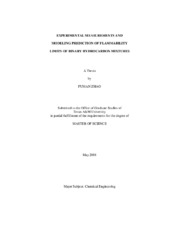| dc.description.abstract | Flammability limit is a significant safety issue for industrial processes. A certain
amount of flammability limit data for pure hydrocarbons are available in the literature,
but for industrial applications, there are conditions including different combinations of
fuels at standard and non-standard conditions, in which the flammability limit data are
scarce and sometimes unavailable.
This research is two-fold: (i) Performing experimental measurements to estimate
the lower flammability limits and upper flammability limits of binary hydrocarbon
mixtures, conducting experimental data numerical analysis to quantitatively characterize
the flammability limits of these mixtures with parameters, such as component
compositions, flammability properties of pure hydrocarbons, and thermo-kinetic values;
(ii) Estimating flammability limits of binary hydrocarbon mixtures through CFT-V
modeling prediction (calculated flame temperature at constant volume), which is based
on a comprehensive consideration of energy conservation. For the experimental part, thermal detection was used in this experiment. The
experimental results indicate that the experimental results fit Le Chatelier’s Law within
experimental uncertainty at the lower flammability limit condition. At the upper
flammability limit condition, Le Chatelier’s Law roughly fits the saturated hydrocarbon
mixture data, while with mixtures that contain one or more unsaturated components, a
modification of Le Chatelier’s is preferred to fit the experimental data. The easy and
efficient way to modify Le Chatelier’s Law is to power the molar percentage
concentrations of hydrocarbon components.
For modeling prediction part, the CFT-V modeling is an extended modification
of CAFT modeling at constant volume and is significantly related to the reaction vessel
configuration. This modeling prediction is consistent with experimental observation and
Le Chatelier’s Law at the concentrations of lower flammability limits. When the
quenching effect is negligible, this model can be simplified by ignoring heat loss from
the reaction vessel to the external surroundings. Specifically, when the total mole
changes in chemical reactions can be neglected and the quenching effect is small, CFTV
modeling can be simplified to CAFT modeling. | en |


